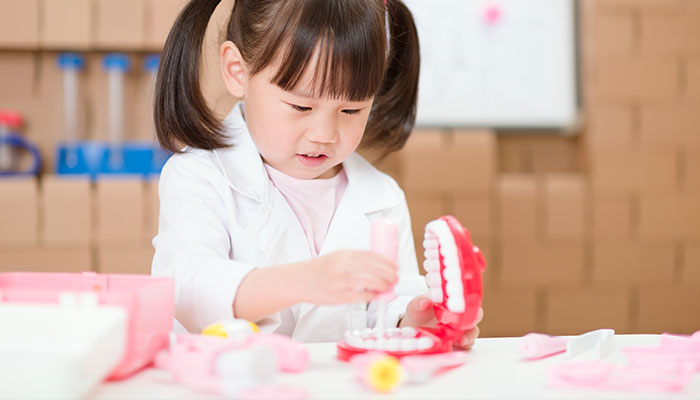While we believe that the books and resources recommended may be of value to you, keep in mind that these are suggestions only and you must do your own due diligence to determine whether the materials are appropriate and suitable for your use. PNC has no sponsorship or endorsement agreement with the authors or publishers of the materials listed.
COMMUNITY HELPERS

Biters & Grinders
Children will learn about dentists and use a variety of materials to learn about how their teeth work.

Lesson Objective
Children will explore their teeth, discover how they work, and learn about how a dentist helps keep teeth healthy.
Science
What You'll Need
- A tooth – either a model or real tooth, if possible
- Staple removers – 1 for each child
- Wooden meat mallets – 1 for each child
- Clay – a golf ball sized amount for each child
- Crackers – 2 for each child
- Small child-safe mirrors – 1 for every 2 children
- Table covering
What To Do
- Invite children to use the mirrors to look at their own teeth. Give them time to look at their friend’s teeth as well.
- What do the children notice about teeth? Where are they? What do they look like? What color/shape/size are they? Are your teeth all the same?
- Point out that we have a variety of teeth in our mouths. They are different sizes and shapes. All of our teeth help us eat, but they have different jobs.
- We have two basic types of teeth, biters and grinders. Biters (incisors) are in the front of the mouth and we use them to bite off pieces of food. Grinders (molars) are in the back of the mouth and we use them to grind food into little pieces.
- The children can use the clay and the staple remover to practice the action of incisors. Give each child a golf ball sized amount of clay. Let them roll it into a snake shape or a pancake shape. They can use the staple remover to take “bites” from the piece of clay.
- The children can use the crackers and the mallet to practice the action of molars. Give each child a cracker. Put the cracker on a paper towel on a hard surface. Let them use the meat mallet to press and grind on the cracker. Explain that their molars do the same thing when they chew on food.
- During snack or lunch, as the children are eating, ask them if they are using their molars or their incisors.
Resources
Home School Resources
Home educators: use these printable lesson PDFs to teach this lesson to your home schoolers. They're available in English and Spanish.
Content Provided By
Common Core State Standards Initiative – These lessons are aligned with the Common Core State Standards ("CCSS"). The CCSS provide a consistent, clear understanding of the concepts and skills children are expected to learn and guide teachers to provide their students with opportunities to gain these important skills and foundational knowledge [1]. Visit the CCSS


